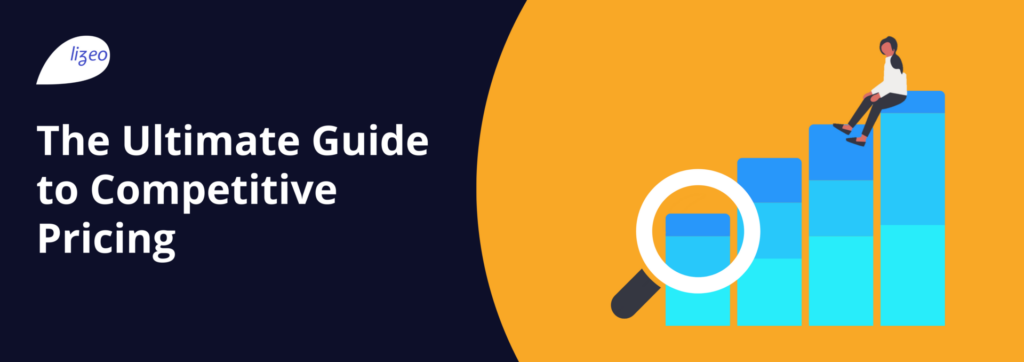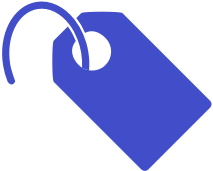
The Ultimate Guide to Competitive Pricing

What is a competitive pricing strategy?
Competition-based strategy–a definition
Competition-based pricing (otherwise known as strategic pricing) is analysing prices set by various businesses, retailers or manufacturers within the same industry, then adapting the price to match or compete with these existing prices.
This kind of competition-driven pricing assists in deciding on which prices place the product with a competitive price market advantage. This increases the value of the product not simply by basing its price on the cost of production, but how the product can compete against similar or identical products of a business competitor in the same market.
To do this, a certain amount of competitive pricing data must be collected to determine how the profit margin shall be affected by changes in the market. This would be an impossible task without being aware of the pricing of competitive business rivals, and whether the product should be set at a lower or higher price. However, it must be taken into account that the value of the products sold should not differ too greatly for the customer, as the end user has the purchase power.
Successfully setting competition-based pricing is much more complicated than it sounds. There is the hazard of being misled by superfluous competitors on the same market, and this is one of the many common business challenges to overcome.
Pros:
- Quick and easy to use
- Complete control over product placement
- Helps to avoid market share losses by benchmarking competitor pricing so your business has better positioning
- First step into incorporating dynamic pricing
Cons:
- Copycat strategies don’t help your product to stand out
- Presumptions that competitor pricing is suitable for your own business goals leaves room for error
- Competitor-based pricing may mean jeopardising margins and selling for lower profits
Dynamic pricing and competitor monitoring
To set the right price for your product, three main tactics must be used in combination – focusing on customers, competitors and of course, costs.
To ensure you are setting competitive prices for your product or service, you must first gain an overall perspective of the market, using data analysis to create a combined pricing and business strategy.
For example, begin by employing a regular pricing strategy to complement a more competitive pricing strategy based on the competitor’s price. You must always be mindful of production costs to create cost-based pricing to determine profit margin objectives. Then in addition, employ competitive pricing strategies aimed at increasing profitability.
This is why you should never underestimate the benefits of competitor pricing data as a benchmark for creating your own pricing strategies. What will set you apart from other businesses in the same sector will be your ability to recognise both conventional and innovative pricing methods to increase the stability and evolution of your brand’s positioning in the market.
The use of real-time pricing, or dynamic pricing, is the method of setting a flexible cost for a product that can be adapted according to market demands. It is a direct and dynamic approach to reach consumers by selling products or services online, whilst matching the ever-changing market price. By analysing the competitor pricing information in real time, prices can be modified in correlation with cost regulations for the full array of your products or services.
Focusing on Price Intelligence
To make smart pricing decisions, it is essential to track, observe and analyse pricing information to adapt to an ever-changing market. As the market changes, so must your prices, ensuring that your pricing position is an informed decision using dynamic strategies to improve your product’s presence. This is what is known as pricing intelligence of which there are five important steps to follow. Pricing intelligence is not just about adapting to price changes, it is about creating long-term profit and developing business growth.

Long-term pricing strategies: Defining the best price for my product thanks to competitor price monitoring
How to price a product in a competitive market?
Competitor-based pricing is based upon product comparability. By monitoring and making comparisons between similar or identical products and services, you can set more accurate and competitive prices to contend with businesses in the same industry.
In order to ensure you are doing this correctly and efficiently, you will need to collate homogeneous pricing information. Once you have prepared this data and decided upon a competitive benchmarking price, you have several options to consider.
- Set a market price that exceeds the competitor’s price. This competitive pricing strategy can only be used if more value has been added to the product. For example, additional or improved features that justify the cost increase and overall value of the product. Branding plays a large part of making this kind of strategy effective.
- Set a market price that precedes the competitor’s price. Introduce a starting market price to encourage upselling. Beware that neither the competitor nor the clients notice a rapid decrease in prices, or that your brand loses value.
- Set a price equal to the competitor’s price. Match the market price but ensure that your product stands out by highlighting its own unique features. Similar or identical products will be selected by consumers thus not on price, but on differentiating features and/or any additional services.
Mastering price data: a new way to gain a competitive edge?
The regular definition and indeed purpose of competitive pricing is to give your company a competitive edge, with the aim of setting you apart from your competitors to increase sales. You should always keep in mind that:
- Pricing has the greatest effect on the revenue of your business
- Brand and product differentiation can put you in a high market position despite competitor saturation
- Setting a lower price does not guarantee a high sales performance. Sales volume is attributed to ensuring that product value and the customer target match
- Consumers may doubt the value of a product if it is under-priced
This is especially true as your company has to face an increasingly complex market landscape:
- Ceaseless increase of market competitors
- Greater variety of customised and innovative products available for the consumer
- Businesses must manage both online and offline references
- Combative and rapid repricing strategies from market competitors
Fact-based competitor price monitoring allows you to confirm your place in the market, stabilising your price positioning whilst matching your consumers demands. Monitoring pricing and the business strategies of your market competitors gives you contentious leverage.

What are the best methods for competitive pricing analysis?
What is the best way to conduct a competitor analysis?
The first step is to determine who your market competitors are within the same sector, based on similar or identical products. Define a series of business cases to outline the data you wish to collect, then specify the range and detail of your intended data collection. For example, which state or country are you targeting, are there certain websites or specific products that you wish to focus on?
Next, begin your search and collect all relevant data regarding pricing. At this stage, you’ll need to prepare your data. Data cleaning and matching are compulsory to make sure your analysis is based on qualitative data. In order to achieve this, and to ensure the accuracy of your study, the use of a product master database is highly recommended.
It is advisable to check out historical price trends, as these can be informative indicators of recurring trends and consumer behaviours within your industry. Observe how competitors used pricing dynamics to boost sales volume or other pricing methods to increase their revenue. As you familiarise yourself more and more with pricing trends and consumer behaviours, you can make more informed data-driven choices to surmount your market competitors.
Finally, you must scale the data you collected and analyse it using an analytics tool (a Business Intelligence tool, for example), to generate clarified visuals or graphs which are easy to analyse, and share with the appropriate team members in the Marketing and/or Sales departments. Visuals and graphs completed by relevant KPIs are powerful tools to present your pricing data, making the information easier to put to direct use.
Using Automation
Retailers and manufacturers need an improved understanding of the positioning of their brand, and the behaviour of their competitors in an increasingly competitive market landscape. This can be achieved by monitoring price changes. Manually monitoring price changes is an outdated approach which not only wastes time but is not always a reliable source of data. This is because there is an extensive amount of data, which would have already been modified by the time an analyst has to manually verify the information they collected. Data collection needs to be scaled to keep up with the rate of a company or business’ growth, but also to match the growth rate of markets and competitors that require price monitoring.
Automation is an effective modern solution for any analyst who wishes to save time and collect cleaner data. It is used in several steps of data preparation:
- Exhaustive data collection, including new products releases
- Accurate product matching, using algorithms instead of manual verification, ensures the matching of the right pricing data to the right reference
- Precise product comparability
- Identification of similar or identical products ensures a more detailed and customised analysis. An algorithm can detect pricing information regardless of variations in website design, layout or naming conventions
The whole automation process ensures that you get the data you need faster and with greater accuracy, allowing your business to expand as the market grows.
How to benchmark market prices? Which data and KPI to use?
Collecting pricing data and converting it into usable information can be challenging, but it is worth the effort. With limited time in a fast-moving business world, competitive intelligence must be narrowed down so you can focus on what matters most for your business.
You can begin tracking the market price by setting the scope of specific data collection sources which are either online or offline (or both) and match your analysis criteria. Next, you can match your collected pricing data or product information with the appropriate reference. You are then ready to analyse the data, however, you cannot expect to fix all your pricing dilemmas with one solution as your pricing strategy must line up with your current situation. Monitoring KPIs that do not align with your business strategy goals denotes the purpose of analysing market data. It can also lead to strategic decisions that are damaging to your business. Certain metrics should always be considered when it comes to competitor price monitoring: price index, price positioning, price history, etc.

What tools to use to compare competitors prices?
BI tools: how to be state of the art regarding price tracking?
Let’s take a closer look at Data Analytics. BI tools assist in analysing important up-to-date pricing data. For most businesses, neither senior executives nor managers have the time or the motivation to dig into the depths of Data Analytics nor the technicalities of BI. Nevertheless, these systems are an indispensable support when making critical business decisions. In a business setting, it is the duty of analysts and operational employees to ensure executives have all the accurate information to support their decisions. BI tools assist the analyst to drill Big Data using filters to segment and extract what will be useful to the company.
Data Viz: how to help an audience gain access to information?
Visualising data is a pivotal aspect of competitor price monitoring. Data Viz gives businesses the ability to construct smart data visualisations, which nowadays is a must-have skill. Communicating data using visuals has become a necessity as an increasing number of collaborators without the technical know-how are required to access data to make business decisions and to share their findings. As technology progresses, an increasing amount of tools can be found online, making it easier for non-technical teams to decipher data thanks to accessible visuals.
Regardless, your preparation of the collected data and its quality is crucial for creating applicable Data Viz, especially if you are dealing with low-quality data.
Moreover, it is crucial to remember that your ability to set strategic objectives is achieved by understanding and using said data. Thus, before choosing how to represent your data, you must identify who your target audience (or user personae) is, and consider how that data may be interpreted or applied based on their data skill level. Automatic alerting is another compelling tool to help businesses benchmark market prices, and identify price strategy examples.
Alerting tools
Analysing a broad amount of competitive pricing examples is not without its complications, especially when you are trying to track a large enough scope to maintain a competitive position in the market. A pricer’s role encompasses a sizable variety of tasks including ensuring a consistent pricing policy for sales support. The sheer volume of pricing examples that must be monitored on a daily basis means that a competitive pricing strategy cannot be secured for every reference perimeter. It is unfortunate that this results in a restricted analysis of key offers and neglects opportunities in niche markets or potential risks on long-tail offers.
So how does an alerting tool work? An alerting tool sets an automatic tariff whilst monitoring the competitive pricing range. This solution ensures you can increase your monitoring parameters, evaluate important trends as well as detecting and alerting you to price changes so they can be improved before an opportunity is lost. The automatic alerting system can warn the pricing team of competitive prices over a short period of time and over various markets of speed and scope. The goal is to maintain a competitive price by monitoring price changes in real-time.

What are some examples of competition-based pricing?
Case study: How does Lizeo help major tyre manufacturers with their competitor price monitoring?
Lizeo assists a variety of related businesses, online retailers and manufacturers to gather valuable competitor data available in order to extract insights. Lizeo also offers automatic tyre pricing monitoring solutions to ensure that your business has direct and rapid access to essential pricing information in real time. Our business intelligence platform gives you not only a global market perspective, but allows you to measure competitive price positioning whilst monitoring competitor pricing using dashboards with automated updates. These forms of automated updates and alerts signal sales prices and can be used to align with target margins, product or company branding as well as product positioning to increase market presence and overall revenue.
The Benefits :
- In-depth comparative analysis of market prices on a consistent basis to maintain a stable market presence
- Foresee pricing trends using accurate market tools to make informed decisions designed by experts
- Enhance target margins and market distribution by setting more accurate automated prices
Regardless of which competitive pricing strategy is implemented for your product or service, competitor price monitoring is an invaluable advantage to your business. Setting a price that matches the competitors’ prices can only be performed successfully if accurate market data is collected to make informed decisions. Lizeo can design, analyse and elicit the information you need from vast amounts of data. Lizeo incorporates experts in marketing, data, product placement and IT to empower their clients with data-based solutions for a competitive edge. Need to enhance your price monitoring skills? Perhaps you would like to request a demonstration of our pricing intelligence solutions?